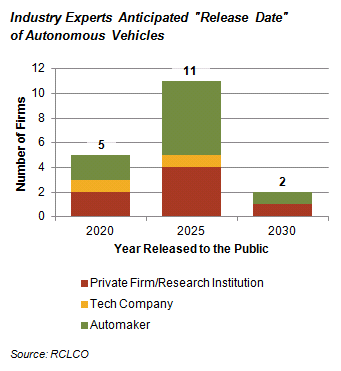RCLCO futuRE Series: A Driverless Vehicle Roadmap for the Real Estate Practitioner – Part 1
Introduction
Fully autonomous, or “driverless,” vehicles (AVs), in one form or another, are going to become a reality within the next two decades and have the potential to bring about sweeping and transformative changes to society generally and real estate specifically. Just as previous landmark innovations in transportation transformed the real estate landscape before, AVs are poised to affect every facet of the industry as we know it today, from land values and development costs to the very existence of certain asset types. Investors, developers, and other real estate professionals who have the vision and foresight to plan accordingly will be able to capitalize on new opportunities as the landscape changes.
Even over the past few months, we have observed a shift in the conversation about AVs within the real estate community as information about technological advancements goes mainstream. While the topic’s introduction previously brought wry smiles or headshaking in conference rooms and at cocktail parties, it now seems to be recognized as an inevitable marvel—even if it still leads to jokes about a pending “robot-pocalypse.” What seems to be missing from the conversation thus far is a deliberate evaluation of the potential implications of AVs on real estate demand and performance.
This article is therefore the first in a two-part series to begin the conversation and advise our clients and industry colleagues on how they might respond to this monumental technological innovation. The article below provides background on AV technology and the potential timing of its introduction and widespread adoption. The next part will describe a range of real estate implications resulting from AVs, and hopefully start to outline a roadmap to begin to plan for their arrival.
Background
Transportation and accessibility are inextricably tied to real estate development and values. Therefore, innovations in mobility have a tremendous impact on where we decide to live, work, and play. Throughout the history of the United States, dominant modes of transportation dictated regional development patterns. For example, urban growth in the East was influenced by the travel patterns of colonists who relied on ships, horses, and their own two feet. Much of the Midwest was developed along rivers and canals, where steamboats spurred the growth of cities like Cincinnati and St. Louis, and then rail lines led to rapid growth in cities like Chicago. The West was initially developed along wagon trails and then eventually rail lines. The dawn of cars had enormous implications for real estate across the nation, quickening the growth of suburbs in all directions from cities across the country.
The introduction of AVs promises to be another transformative advancement in urban mobility. For decades, people from science fiction authors to engineers dreamed of a day when humans could rely on automated systems to make transportation more convenient, efficient, and safe. Attempts to bring about driverless transportation solutions generally focused on automating the infrastructure rather than the cars, which was prohibitively expensive and ultimately impractical. The 21st century introduced the requisite processing power, sensor technology, and network connectivity to shift the focus from the infrastructure to the car, and these dreams are now taking shape. Major strides in components such as computers, digital maps, cameras, lasers, radar, and wireless internet have contributed to progress in autonomous driving that was unimaginable just 10 years ago. Even though obstacles still remain, the conversation has shifted almost entirely from “how” and “if” to “when” and “where.”
Timing
Accurately predicting when autonomous vehicles will achieve significant market penetration is a difficult task considering the many legal, technological, economic, and social factors that must come together to make widespread AV adoption a reality. A slew of legal questions concerning government regulation, consumer privacy, and ethical responsibility are particularly daunting. Existing technological limitations, such as fallible/hackable systems, incomplete maps, and weather-dependent hardware, must be overcome in order to ensure that the vehicles are consumer ready. However, even if AVs were released to the general market today, consumer resistance due to high prices and safety concerns could temper market demand (and, as Tesla’s recent rollout of its “Autopilot” system has demonstrated, consumer education is still a major priority). Politically, autonomous vehicles could face opposition in certain markets where employees in established market sectors, such as truck or taxi drivers, may feel threatened by the propagation of automation.
 In light of the rapid technological advances, and in spite of the remaining obstacles, many industry experts predict fully autonomous vehicles will be released to consumers sometime within the next 15 years. Many leading research institutions, consulting firms, tech companies, and automakers project autonomous vehicles will hit the market between 2020 and 2030 (Figure 1). Studies and reports released by groups such as IHS1, BCG2, and Frost and Sullivan’s3 suggest that AVs should be “commonplace” by 2040. Although it is impossible to accurately predict when AVs will achieve widespread adoption, the prevailing optimism from many industry leaders suggests that they will be here sooner rather than later. In the meantime, moreover, automakers will continually release cars with increasing levels of automation, such that the advent of full automation will likely seem incremental rather than radical.
In light of the rapid technological advances, and in spite of the remaining obstacles, many industry experts predict fully autonomous vehicles will be released to consumers sometime within the next 15 years. Many leading research institutions, consulting firms, tech companies, and automakers project autonomous vehicles will hit the market between 2020 and 2030 (Figure 1). Studies and reports released by groups such as IHS1, BCG2, and Frost and Sullivan’s3 suggest that AVs should be “commonplace” by 2040. Although it is impossible to accurately predict when AVs will achieve widespread adoption, the prevailing optimism from many industry leaders suggests that they will be here sooner rather than later. In the meantime, moreover, automakers will continually release cars with increasing levels of automation, such that the advent of full automation will likely seem incremental rather than radical.
Implications
The status quo, an environment of predominantly human-operated vehicles, is characterized by significant economic loss, societal harm, and health damage each year. Across the United States, nearly 5.5 million car accidents occur annually, resulting in 35,000 fatalities4 and an estimated $871 billion in cost5. Additionally, it is estimated that traffic jams and congestion cost Americans $160 billion dollars each year in lost productivity, wasted fuel, and increased vehicle maintenance6. Car ownership today is a very inefficient use of resources, with the average car parked over 22 hours per day and our cities often serving as storage space for millions of underutilized cars7. Considering that accidents and congestion are mostly byproducts of human error, replacing human beings behind the wheel could have monumental benefits.
The extent of autonomous vehicles’ impact likely depends on whether the future is characterized by owned autonomy or shared autonomy. The future may involve a shift in both the ownership and operation of cars, from owned and manually operated assets to shared computer-operated assets (Figure 2). Currently, we have a human-operated landscape with a mix of traditional private ownership (Q3) and emerging shared alternatives like Uber or Zipcar (Q4). AVs will be computer operated and either owned (Q2) or shared (Q1) similar to today. Private autonomous ownership might involve a family car that shuttles parents to work and kids to school/activities, while parking at home or a charging station between trips. Shared autonomy may be similar to a rideshare experience today, although the cost per trip could drop significantly with no human operator and greater fuel efficiency. Without the human element in either scenario, AVs will be able to drive closer together and communicate with each other, thus making driving much safer and more efficient. The future of AVs may ultimately be a mix of both the owned and the shared scenarios depending on consumer preferences, government regulations, and geographic characteristics.
 Both forms of automotive autonomy have the potential to disrupt and transform nearly every aspect of society, from the economy to the environment. Potential economic impacts include increases in productivity, infrastructure capacity, vehicle utilization, and the cost of vehicle ownership, as well as decreases in traffic congestion, property damage, transportation-related employment, private insurance coverage, car ownership, and supply chain costs. Decreases in congestion and increases in vehicle utilization would likely have positive environmental impacts such as lowering noise and air pollution and reducing fuel consumption. Conversely, as commuting becomes less inconvenient and the time spent in the car becomes more productive, people may be more willing to live farther away from urban areas, potentially resulting in increased emissions and less efficient land use.
Both forms of automotive autonomy have the potential to disrupt and transform nearly every aspect of society, from the economy to the environment. Potential economic impacts include increases in productivity, infrastructure capacity, vehicle utilization, and the cost of vehicle ownership, as well as decreases in traffic congestion, property damage, transportation-related employment, private insurance coverage, car ownership, and supply chain costs. Decreases in congestion and increases in vehicle utilization would likely have positive environmental impacts such as lowering noise and air pollution and reducing fuel consumption. Conversely, as commuting becomes less inconvenient and the time spent in the car becomes more productive, people may be more willing to live farther away from urban areas, potentially resulting in increased emissions and less efficient land use.
Autonomous vehicles may also have broad socioeconomic implications, as the disabled, elderly, young, and disadvantaged individuals experience increased mobility and become more active participants in the economy. These segments of the population, which often rely on inconvenient and expensive mass transit options or relatives for their transportation needs, may have access to jobs and entertainment not previously available. In the future, the technology could be scaled to larger vehicles, potentially expanding public bus service to bring even lower cost transportation to more people. Although no one can predict what will happen as we transition to an autonomous future, we can be certain that profound and lasting changes are on the horizon.
Conclusion
Autonomous vehicles are coming and have the potential to profoundly impact many facets of society, including real estate. For a perspective on what the real estate industry might look like in a future influenced by autonomous vehicles, please look out for Part 2 of this series, which is set to be released later this month.
1 “Self-Driving Cars Moving into the Industry’s Driver’s Seat,” IHS, January 2, 2014, accessed March 9, 2015, http://press.ihs.com/press-release/automotive/self-driving-cars-moving-industrys-drivers-seat/
2 Xavier Mosquet et. al., “Revolution in the Driver’s Seat: The Road to Autonomous Vehicles,” bcg.perspectives, April 21, 2015, accessed April 28, 2015, https://www.bcgperspectives.com/content/articles/automotive-consumer-insight-revolution-drivers-seat-road-autonomous-vehicles/
3 Dave Smith, “Self-Driving Cars Will Really Take Off In 5 Years,” Business Insider, December 23, 2014, accessed April 28, 2015, http://www.businessinsider.com/self-driving-cars-2014-12/
4 “Road traffic deaths”, World Health Organization: Global Health Observatory Data Repository, 2010, accessed September 20, 2015, http://apps.who.int/gho/data/node.main.A997?lang=en
5 Larry Copel, “Staggering Toll: Car Crashes Cost $871 Billion a Year,” USA Today, May 29, 2014, accessed September 20, 2015, http://www.usatoday.com/story/news/nation/2014/05/29/steep-economic-toll-of-crashes/9715893/
6 Jim Forsyth, “U.S. Commuters Spend about 42 Hours a Year Stuck in Traffic Jams,” Reuters, August 26, 2015, accessed September 15, 2015, http://www.reuters.com/article/2015/08/26/us-usa-traffic-study-idUSKCN0QV0A820150826/
7 Paul Barter, “‘Cars Are Parked 95% of the Time’. Let’s Check!,” Reinventing Parking, February 22, 2013, accessed September 21, 2015, http://www.reinventingparking.org/2013/02/cars-are-parked-95-of-time-lets-check.html
Disclaimer: Reasonable efforts have been made to ensure that the data contained in this Advisory reflect accurate and timely information, and the data is believed to be reliable and comprehensive. The Advisory is based on estimates, assumptions, and other information developed by RCLCO from its independent research effort and general knowledge of the industry. This Advisory contains opinions that represent our view of reasonable expectations at this particular time, but our opinions are not offered as predictions or assurances that particular events will occur.
Related Articles
Speak to One of Our Real Estate Advisors Today
We take a strategic, data-driven approach to solving your real estate problems.
Contact Us







